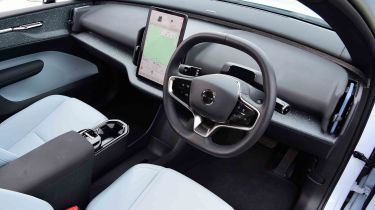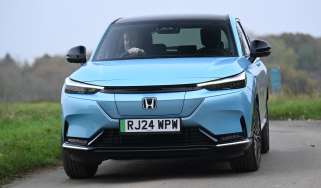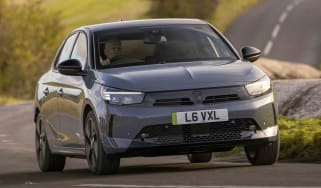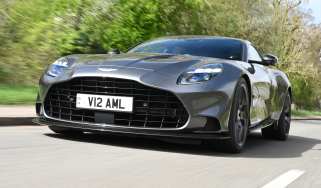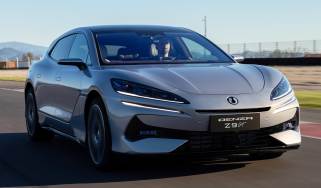Volvo EX30 - Design, interior & technology
The interior looks and feels great and has lots of high-end features, but usability could be improved

The EX30 looks familiar to the brand's other SUVs, thanks in no small part to details like the ‘Thor’s’ hammer LED headlights and high-mounted rear lights. It’s chunky and substantial at first glance, even if, in reality, it is actually shorter than a Volkswagen Golf.
There are five exterior colours to choose from, and thankfully, all of them are free. You can also pick between four interior colours, although your options might be limited by the trim you choose. Pine is exclusive to Plus trim, and the top-of-the-range Ultra adds Breeze and Mist colour schemes into the mix.
Typical of Volvo, the dashboard design leans heavily on a minimalist aesthetic. There have also been some cost-cutting measures to achieve this price, but at first glance, Volvo has done incredibly well to hide them. The dashboard and seat covers feature woven fabrics and recycled materials – including one constructed from recycled denim and another from old PVC window frames. The overall effect looks unique and makes the cabin feel more expensive and special than anything at this price point.
While the simplified design looks good, we feel it’s gone too far in terms of useability. Almost everything is controlled via the central touchscreen; in some areas, like the Google-based navigation system, it’s brilliant, but there are flaws with almost every function being controlled through the screen. We don’t have an issue with electric mirrors buried within the sub-menu – most people will adjust them once and then leave them alone – but other useful functions, like the rear window demister, are too fiddly to access easily. Given that Euro NCAP will be incentivising manufacturers to maintain certain frequently used functions as a physical button to achieve a five-star safety rating, we hope this decision is reversed when the car is facelifted.
You’ll also need to get used to a window switch design that appears to be heavily influenced by VW and its ID electric cars. The speakers and electric window switches have been removed from all the EX30’s doors to save on space and enlarge the door pockets (it’s also a cost saving due to a reduction in the amount of wiring), with the switches moving to the centre console. Like in the Volkswagen ID.3 the front switches also control the rear windows when you press the ‘Rear’ button. We suspect you’ll get used to it over time, but it's not immediately obvious.
All versions come with a 12.3-inch central touchscreen in a portrait layout. In Tesla fashion, it displays all vehicle information and removes the driver instrument cluster from the dashboard, contributing to a cleaner look. We’d prefer a small supplementary screen attached to the steering column, like you’ll find on the ID.3, to display things like the speedometer, gear position, and trip information in front of the driver who needs that sort of information, rather than having to refocus from the road and look across at a screen. If Volvo is to persist with such a minimalist design, at least give us a head-up display as standard – like you’ll find on the Mazda MX-30 – to project all this important information onto the windscreen within the driver’s line of sight.
Sat-nav, stereo and infotainment
Like we mentioned in the section above, the central touchscreen displays and controls all vehicle functions. Below the speedo at the top of the screen comes the sat-nav, audio, and phone widgets, with the lowest section of the screen devoted to a row of commonly used functions followed by a section of actual switches at the bottom to control things like the windscreen demist function and the hazard warning lights – the latter has to be a physical button by law.
The system will ‘learn’ your most commonly used functions and place them on a shortcut page, but you cannot choose these yourself. Volvo says it will roll out over-the-air updates to improve the interface based on customer usage, so we’re curious to see how the system develops.
All EX30 models get Apple CarPlay smartphone connectivity with wireless charging, but not Android Auto. The system uses Google software with four years' worth of unlimited mobile data to use with apps on the system and for in-vehicle communication.
A 1,040-watt Harman Kardon premium sound system is standard from Plus trim and above, featuring seven speakers in total, including a dashboard soundbar and a subwoofer in the boot. The entry-level Core trim uses a five-speaker set-up with 100-watts of output.
